Menu
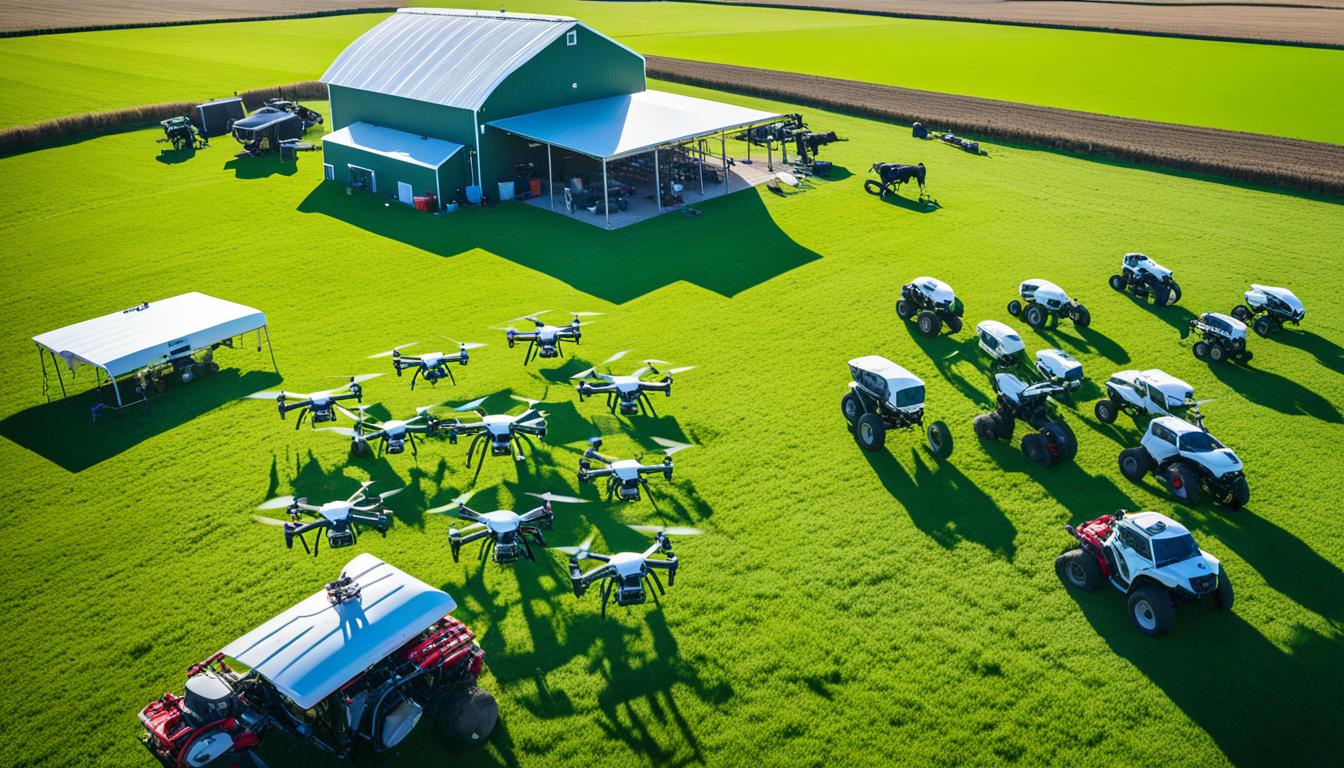
Have you heard that keeping track of livestock health in real time can cut down disease impact by 25%? Farmers are now embracing high-tech ways to keep animals healthy. This includes using smart collars and devices that attach to animals to monitor their vital signs closely.
With this new tech, there’s no more need for old, tiring methods of checking on animals. Now, it’s easier and quicker to act fast when an animal is unwell. This leads to a healthier group of animals, which in turn boosts farm work efficiency.
Livestock management has changed a lot thanks to new tech. This tech aims to make animals healthier and keep an eye on them better. These new ways are much better than looking at the animals by hand, which was not very exact or effective. Now, we have tools that let us watch over the animals much more carefully.
Our world is growing, and soon we’ll need lots more food. By 2050, we might need 70% more food than we do now. This big need pushes us to find new, smarter ways to farm. IoT, or Internet of Things, is one big idea helping us farm better, especially with animals. The CowDevice, a part of this IoT world, is very important. It helps keep watch over cows’ health. This is a big step forwards.
The CowDevice goes around a cow’s neck and uses special sensors. These sensors check on the cow all the time, up to 20 times in a second! The system is very smart. It talks to other devices not too often, saving a lot of energy. This way, the device’s battery can last up to 5 years, so you don’t have to change it often. Even as it sends information often, it does so in a way that doesn’t make it use too much power. This is why the device can live for so long without a new battery. And all the data it sends is clear and trustworthy.
There are also special devices called Hubs. They help by collecting all the information sent by the CowDevices. Then, they send this information to a powerful computer in the cloud. This computer does a lot of work. It keeps a record of all the information. It also makes plans and sends alerts if something needs attention. This whole set-up makes sure the animals are looked after well.
Adding to the smart tech, AGCO has come up with amazing things using AWS. They can predict how much food the animals need. Then, they process all this information in a smart way. This makes taking care of the animals easier. They also make sure all this information is very safe. They use special ways to check who gets to see this info and how it’s kept secure.
In 2016, over half of the livestock tech used sensors. This part of tech is only going to get more popular. By 2029, it could be worth over 11 billion dollars. These numbers show how important and useful this tech is getting in looking after animals.
| Category | Details |
|---|---|
| IoT Technology | Key for efficiency and productivity in agriculture. |
| Monitoring Device | CowDevice with sensors at 20 Hz and battery lasting up to 5 years. |
| Data Transmission | BLE advertisement messages sent every 250 ms. |
| Cloud Server | Manages databases, raises alarms, and communicates with applications. |
| Security Measures | Data encryption and access control via AWS IAM policies. |
| Market Share | Sensors held 51% in 2016; anticipated market value of USD 11.18 billion by 2029. |
Livestock health monitoring systems change the way farms are managed. They offer tools for better animal welfare assessment and livestock disease prevention. This leads to farms producing more while being sustainable.
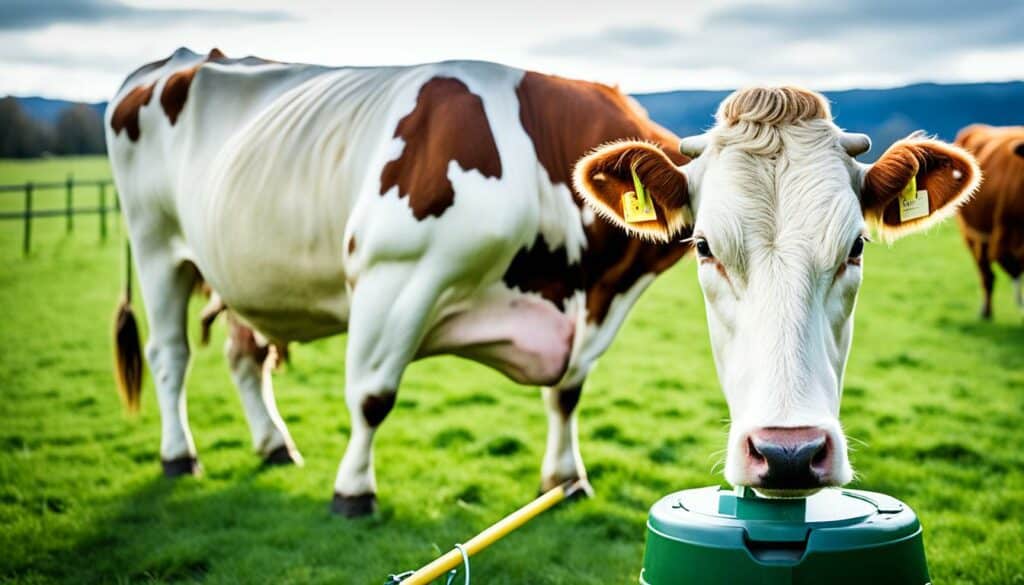
With advanced health monitoring, we can track animal welfare better. This means checking the animals’ temperature, heart rate, and how they move. It helps find health problems early and treat them quickly, which also reduces the animals’ stress and pain. The dairy sector uses these sensors a lot. They help in taking very good care of the animals (Rutten et al., 2013).
Using health monitoring tech makes farms run better. It stops the need for lots of manual checks. This allows farmers to use their time and resources better. Acting quickly on any health issues helps stop diseases from spreading. For dairy cattle, this tech can find lameness and measure how much pain they’re in. This means they get treated quicker and have less time off sick (Chapinal et al., 2010).
Also, using sensors to watch how cows chew and behave when they eat helps improve their eating patterns. This improves the land by lowering soil erosion and making it healthier. Studies have shown the benefits in China (Yu et al., 2019). This mix of using tech for health and better land care shows the big gains in both animal wellbeing and strong farms (Teague et al., 2016).
| Aspect | Benefits |
|---|---|
| Animal Welfare | Consistent health assessments, early issue detection, stress reduction |
| Farm Efficiency | Reduced manual checks, timely interventions, optimized grazing patterns |
| Environmental Impact | Reduced soil erosion, improved soil health, lower carbon footprint |
Old ways of keeping an eye on animals mainly involve looking at them and checking up on them often. These methods are hard work and might not catch illnesses early. This could make managing a group of animals hard and put their safety at risk.
One main issue with the old methods is that they take a lot of effort. You have to look at each animal one by one, which can be very time-consuming. It’s particularly tough if you have a lot of animals. And, you might miss the first signs of sickness this way.
A study from Oklahoma University showed this problem. Many sick cattle were not spotted quickly enough, causing big health and money problems.
Sick animals can move their illness to others without us knowing. This makes it harder to keep the group safe. Also, not spotting sickness early can mean less work gets done and money gets lost. Using only the old methods can mean always struggling to keep up with problems, not preventing them.
Let’s look at how sickness hurts the economy:
| Livestock Category | Economic Impact |
|---|---|
| Cattle & Calves | $907.8M annually |
| Pork Industry | $560M annually |
| Sheep & Goats | 5.6% of all diseases |
These numbers show why we need better ways to watch over animals. Improved ways can keep animals safer and make sure businesses do well. They also protect the animals themselves.
The Internet of Things (IoT) is changing the way farmers care for their animals. It uses tech to track the health of livestock. This includes wearable gadgets and sending data in real time.
In 2016, wearable sensors made up over half of the tech used in tracking livestock. They keep an eye on things like temperature and air quality. This helps spot sickness early, leading to quicker treatment.
Thanks to IoT, data about animals can be sent instantly. Even on distant farms, this LoRaWAN tech keeps working. It sends information to the cloud, giving farmers a detailed look at the health of their herds.
Anticipated growth in IoT for farming is big news. By 2029, spending on this could reach over 11 billion dollars. It’s not just good for animals; it helps farmers by offering detailed info and advice for better herd care.
Advanced monitoring technologies go way beyond basic tracking. They use advanced data collection and interpretation. They help us see small changes in both behaviour and health that we couldn’t before.
The SenseHub Dairy system by Allflex is a standout. Its 98-gram device lasts 7 years. A lighter version, 25 grams, lasts 3 years. They pass on data about dairy cow behaviour to the SenseHub Controller. This makes long-term monitoring easy.
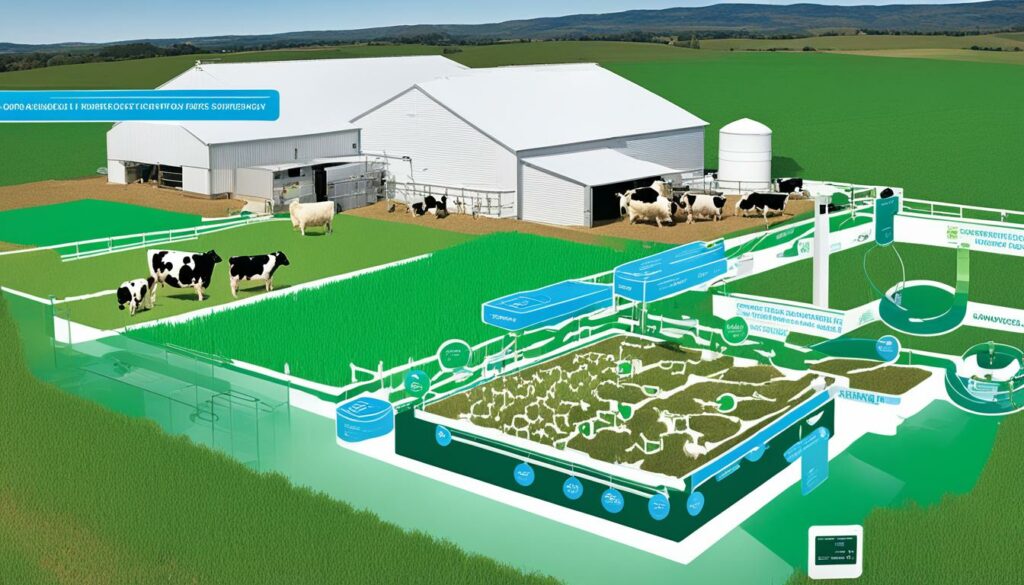
Two key products are Afimilk’s Advanced Neck Collar and AfiCollar. The Advanced Neck Collar is great for heat detection, and it tracks how your cows eat and digest food. It also checks their activity all the time.
The AfiCollar is even more advanced. It looks at rumination, eating, and movement. It then warns you about single cow health or the health of your whole group. This device works with other tools to also check on milk quality.
| Device | Battery Life | Weight | Key Features |
|---|---|---|---|
| SenseHub Controller Device | 7 years | 98 grams | Collects and transmits behavioural data |
| SenseHub Lighter Device | 3 years | 25 grams | Efficient data collection |
| Advanced Neck Collar | – | – | Accurate heat detection, rumination monitoring, 24/7 wireless activity monitoring |
| AfiCollar | – | – | Monitors behaviour, alerts for health issues, assesses milk quality |
These technologies don’t need any upfront payment. You pay monthly. They keep getting better with software upgrades and come with warranties. This makes them a smart choice for farmers.
In the end, these tools help us manage animal health well. They let us make better choices and keep our animals healthy.
Today, cutting-edge livestock management relies heavily on advanced technologies. For instance, GPS tags and accelerometers are key tools. They give us a deep understanding of what animals do. This helps us spot any health issues early. By using these technologies, we can make sure our animals are well taken care of. At the same time, it makes farm work run smoother, making everything more efficient.
Thanks to GPS tags, we can watch our livestock graze non-stop. This technology came into its own in the late 1990s. It lets us keep an eye on our animals for weeks or months. By combining the GPS with maps and systems that hold geographical info, we learn a lot. For example, we can see how to place supplements to make cattle go to areas we need them to. Also, special devices called ‘lifecorder plus’ keep a sharp eye on how long animals are grazing. This data helps us manage the whole herd better.
Equipment like accelerometers is a game-changer in spotting health problems in livestock. These gadgets pay close attention to how animals move, down to 25 times a second. They’re great at picking up on little changes that might mean an animal isn’t well. Thanks to the big leaps in machine learning and artificial intelligence, understanding what these devices tell us has gotten a lot better. Now, thanks to fancy collars on cattle, we can even tell when a cow is walking funny (which might mean they’re ill). Catching these problems fast helps us look after our animals well, which keeps them healthy and working.
Preventing disease spread in animals is key in farming today. 75% of new dangerous germs come from animals. Using advanced tools for livestock health monitoring helps farmers act before diseases spread.
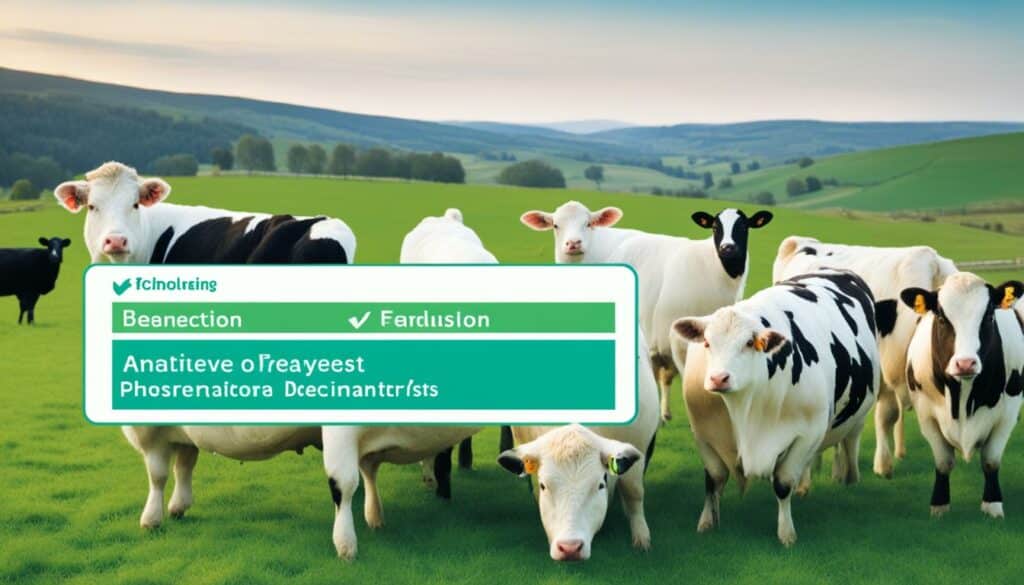
Studying how animals move can show us if they’re sick. With new movement analysis tech, we can spot when they act different. This lets us find and fix health issues early, stopping big problems in the whole group.
Watching how animals behave helps too. If they start acting strange, like moving less or eating differently, it might mean they’re getting sick. By keeping an eye on these signs, we can stop diseases from spreading by acting quickly.
| Statistic | Description |
|---|---|
| 75% | Emerging infectious organisms pathogenic to humans are zoonotic in origin |
| $80 billion | Economic loss due to six major zoonotic disease epidemics (1997-2009) |
| 17 countries | GHSA implementation in phase 1 countries in Africa and Asia |
| 11 action packages | GHSA allocated funds that included zoonotic diseases |
| 1 hour | Time to accurately trace interstate movement of cattle and bison |
Smart livestock monitoring has changed how breeding works. It gives precise data on when animals are ready to mate. This means higher success in getting animals pregnant and better preparation for when they give birth. It’s key to keeping a healthy and efficient herd.
Wearable sensors and data systems now track when animals are ready to mate. They look at things like temperature changes and how animals act. This helps farmers pick the best times for mating. Less guessing means healthier baby animals and better herds.
High-tech monitoring is also used to plan mating times. It looks at data from sensors to pick the best time to mate animals. This better planning saves money on workers and makes breeding more successful. It’s a big help in making farms more productive and profitable.
Using advanced technologies in farming is key today. It helps make grazing better for the land and the animals. With tools like historical data and GPS, we can choose the best places for animals to graze. This can lead to healthier animals and lands.
Gathering and looking back at data can tell farmers a lot. It helps to find the spots where animals often graze. Knowing this can help plan better, so lands don’t get too stressed. This practice makes pasture management more friendly to the environment.
GPS helps to keep an eye on where the animals go. This means we can guide their grazing to protect different plants and the soil. It makes the food animals eat better, making them healthier.
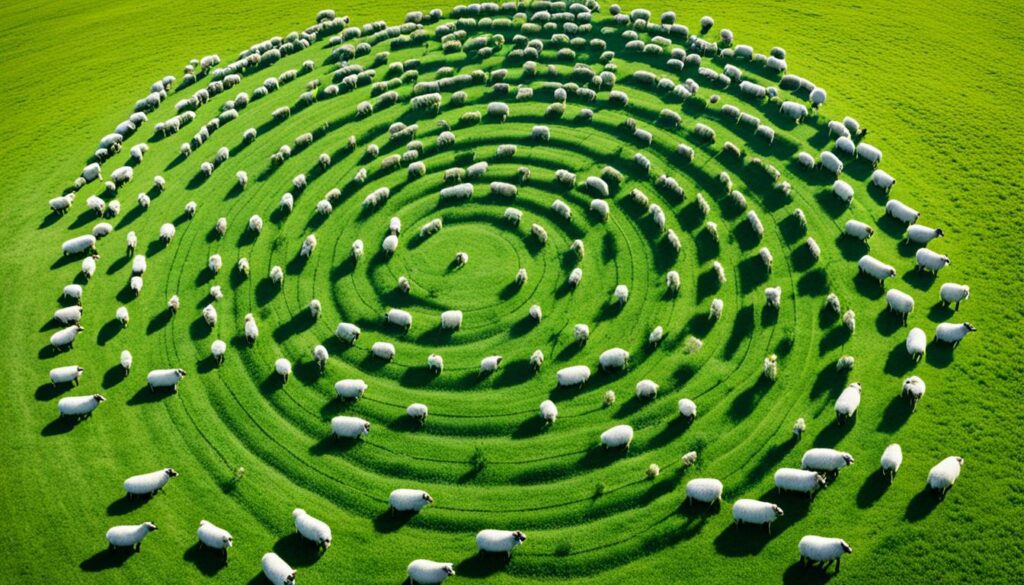
| Benefits | Statistics |
|---|---|
| Global AI in agriculture market growth | 22.55% CAGR |
| Increased pasture productivity and grass yields | Proven through AI integration |
| Reduction in input costs (fertilizers, irrigation, labour) | Significant cost savings |
| Improved livestock health, weight gain, milk production | Confirmed by modern technologies |
| Promotes sustainability | Prevents overgrazing and soil erosion |
| Increased profits and long-term development | Beneficial for farmers |
| 20% increase in milk production | Dairy farm case study in the Netherlands |
| Reduction in cattle loss | US ranch case study |
| Enhances herd health and productivity | Utilising Precision Livestock Farming (PLF) |
| Effective disease detection and herd health management | Enabled by sensor-based technologies |
Veterinary surveillance and quick action are key to keeping animals healthy. It’s vital because many diseases that start in animals can jump to humans. By using high-tech tools, we can spot signs of diseases early. This means we can act fast to stop major disease outbreaks.
Animals often get sick with illnesses that humans can also catch. This makes them very good at warning us about dangers, like bioterrorism. When they get ill more than usual, it tells us something bad might be happening. So, watching animal health closely helps keep us safe.
The World Health Organization says diseases from animals are a big risk, especially now because of human activities. With modern tech, we can watch out for these diseases and stop them from spreading. Acting early saves both animal and human lives from disease risks.
A study in the Netherlands from 2009 found a disease spreading between animals and people. Also, the animals were not responding to treatments. This forced us to find new ways to control the disease. The link between human and animal health info shows we need to work together to fight diseases.
| Study Year | Findings |
|---|---|
| 2016 | Annual report highlighted trends in small ruminant health from cattle census data. |
| 2014 | Identified medication resistance in small ruminants, necessitating new control measures for stomach parasites. |
| 2013 | Revealed multiple anthelmintic resistance in Haemonchus contortus within a Dutch sheep flock. |
| 2010 | Assessed the prevalence of ivermectin resistance among gastrointestinal nematodes in sheep. |
| 2000 | Reported triclabendazole resistance in Fasciola hepatica affecting cattle and sheep. |
| 2009 | Surveillance uncovered intensive Q fever transmission. |
| 2011 | Research focused on reducing the prevalence of Coxiella burnetii via vaccination of goats and sheep. |
Using good veterinary surveillance does more than just help animals. It strengthens how we protect public health too. The use of advanced tools is making our fight against diseases stronger. This leads to more health and sustainability in farming.
Livestock health monitoring systems are key to better biosecurity. They use real-time alerts to help farmers stop disease spread fast. These technologies are crucial for keeping farms productive and their reputation strong.
Using strong health monitoring can greatly cut down on diseases. For example, a study showed that better biosecurity in Europe’s broiler farms meant less need for antibiotics. Tools like access control and keeping things clean are vital for stopping diseases before they start.
Real-time alerts are a game-changer for disease prevention. They help farmers act fast to stop illnesses from spreading. A study in Bangladesh found that good biosecurity meant they used fewer medicines on chicken farms. Quick health responses save money and keep animals healthier.
Livestock software like EcoDocs makes managing biosecurity easier. It helps keep track of protocols and makes sure they’re working well. This, together with quick alerts and preventive steps, saves money and lifts animal wellbeing.
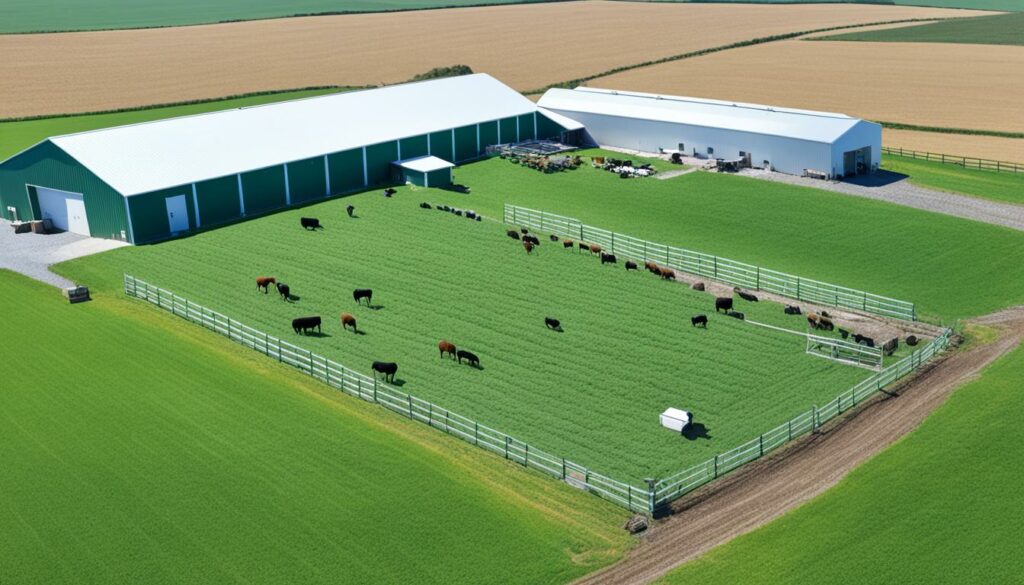
| Study | Findings |
|---|---|
| Zhang et al. (2015) | Antibiotics emission in China river basins linked to bacterial resistance |
| Joosten et al. (2022) | Biosecurity and antimicrobial usage evaluation in European broiler farms |
| Sarrazin et al. (2019) | Antimicrobial usage patterns in farrow-to-finish pig farms in Europe |
| Imam et al. (2021) | Correlation between biosecurity practices and antimicrobial usage in Bangladesh |
By 2050, the global population might hit 9.15 billion. So, smart farm management is key. Machine learning is crucial here. It helps make sense of the data from tracking livestock health.
Machine learning turns sensor data into smart advice for farmers. Thanks to AI, farm management is getting a big upgrade. Now, it’s easier to keep a close eye on livestock.
AI speeds up health checks for animals, giving farmers quick tips. It helps see health problems early by watching how animals move and act. This reduces disease risks.
Machine learning analytics are great for farmers too. They ensure the crops are good and animals are healthy. By looking at old data, they spot health clues early, making the herd safer.
Using GPS tags and sensors, machine learning checks on the animals night and day. It helps keep the farm running smoothly. By looking into animal buildings and offering instant advice, it boosts productivity.
Livestock health monitoring is key for today’s farms. It lets farmers keep an eye on their cows’ health and eating habits all day. They use tools like Nedap Health Monitoring, Smarttag Neck, and Smarttag Leg to watch things like eating, walking, and lying down.
This early watch helps catch health problems before they get bad. So, cows might not drop in milk, struggle to have babies, or need to leave the farm. Watching cows closely before and after they have a calf makes a big difference. It cuts down on health issues and stress.
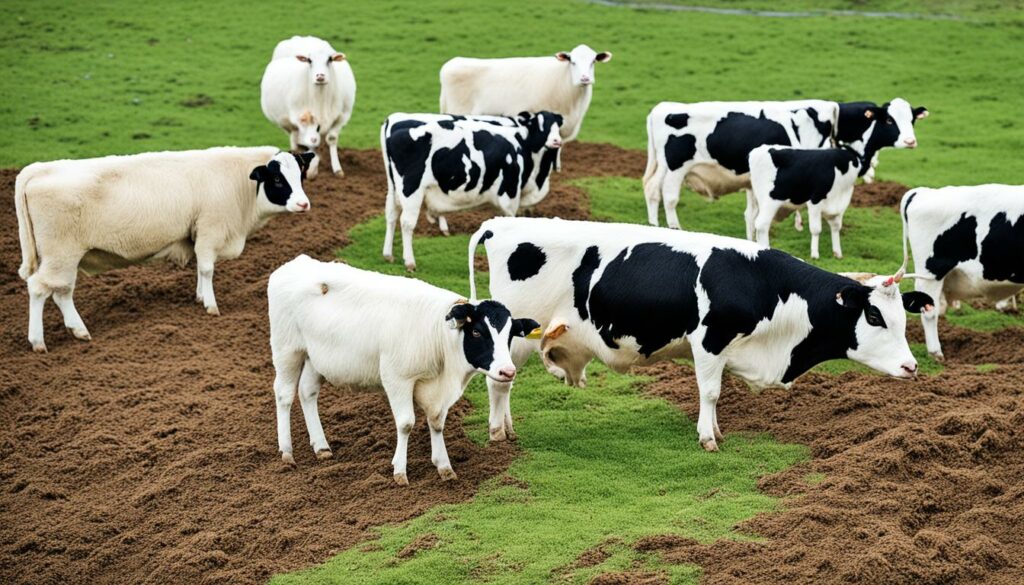
Joep Driessen points out that one sick cow needs as much care as 40 healthy ones. So, spotting issues early and treating them fast matters a lot. This kind of care improves the farm in many ways. It makes work easier, keeps cows healthier, and saves money on vet bills.
Adding health monitoring to heat and cow position tracking boosts the whole farm’s efficiency. Using more Nedap tech does even more good. It helps farms stand out as healthy, efficient places.
In today’s farming, real-time monitoring is a game-changer for animal welfare. It gives us quick info about the health and behaviour of livestock. Studies from 2008 to 2020 show that using high-tech tools really helps dairy farming stay sustainable. With real-time monitoring, we can spot health issues early. This helps stop diseases and keeps animals calm.
New methods like this are much better than old ways. Those old methods struggle to spot when animals feel or act differently due to poor health. But today, tech can catch health problems fast. This means farmers can act quickly to help sick animals. A 2013 review praised how sensors can help manage health on dairy farms. And a 2016 study found that using smart algorithms to watch animals while they graze also works well.
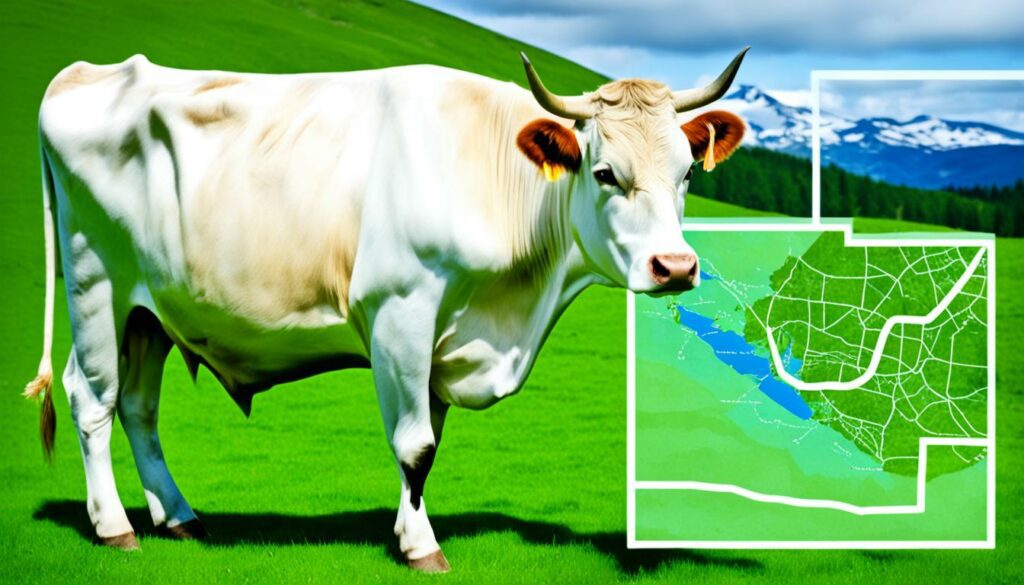
Also, using devices that animals wear, like smart ear tags that check temperature and heart rates, really works. Several studies from 2014 and 2019 supported this. These gadgets measure animal health data. This leads to better care for the animals. By adding IoT tech, sharing this data easily becomes possible. This helps improve animal welfare overall.
By adopting these new ways, we raise the bar for how we take care of animals. This keeps us in line with the latest ethical standards in farming. Studies from 2012 and 2016 show how regular checks on things like stomach pH are crucial. These checks, part of real-time monitoring, aim for a healthier space for animals, making them more productive.
The world of livestock monitoring is getting ready for big changes. It will all be thanks to artificial intelligence and tracking from afar. This new way of doing things will make work smoother and animals healthier.
Artificial intelligence (AI) is changing how we look after farm animals. It moves us from just reacting to problems to stopping them before they start. With powerful AI, we can spot health problems early, saving money and keeping animals in top shape. In 2022, high-tech tools made the biggest splash, with a 42% share of the market. These tools will only get smarter.
Remote control is making farming huge areas easier. Thanks to the internet and aerial drones, farmers get information instantly from far away. Companies in the US and UK are leading the charge. They’re making it possible for farmers to keep an eye on their animals no matter where they are. By 2032, this technology is expected to boost the livestock monitoring market to over USD 23.35 billion.
Looking ahead, automation on farms and using the cloud will be key. These trends will make AI and remote control even better, helping farmers work smarter. Dairy farming will see big benefits from these changes. It’ll create a strong mix of new tech and old farming ways.
IoT technologies are changing how farming works. They are especially helpful in managing livestock. Case studies have shown that by using these technologies, farmers can keep their animals healthier. This leads to better income for the farmers.
On a dairy farm, IoT-based systems have cut down on cattle getting sick. These systems check vital signs in real time. This means the farmers can see when something is wrong early and get the animals help quickly. Because the animals are healthier, the whole farm runs better.
Using IoT in livestock also saves farm money. For example, a cattle ranch used smart collars and IoT to lower vet costs. They check the cattle’s health all the time. This reduced how much they spent on treating sick animals. It also meant the animals stayed healthy more often. As a result, this farm got 15% more work done. And they saved money, too.
| Case Study | Improved Health Outcomes | Economic Benefits |
|---|---|---|
| Dairy Farm A | Reduced cattle illnesses; Prompt veterinary interventions | Increased productivity; Lowered veterinary costs |
| Cattle Ranch B | Early detection of health anomalies | 15% overall productivity increase; Significant cost savings |
In summary, the field of livestock health monitoring is changing. It’s making animal lives better and farms more efficient. With wearable tech and quick data analysis, farmers use smart algorithms. This blend of new tech and old ways ensures animals are healthier and farms do well.
But, there are areas needing attention. The current systems could look at pollution’s effect on animals with few changes. Yet, slow change stops us from using animals to see environmental dangers. Also, not enough money has been put into programs to use animals as an early warning for health threats. This makes it hard to trust the data they give for human health predictions.
Quickly spotting animal diseases due to the environment helps us find human health risks. The committee says we should watch disease outbreaks in both animals and people who live together. This early warning is crucial. Also, we need to know how many pets are in the US to track diseases better. This needs teamwork and a joined-up plan across the country. Doing this would avoid wasting effort and make animal health warnings consistent.
Livestock health monitoring uses IoT devices like smart collars. It tracks the health of farm animals, mainly cattle. These devices watch over things like location and vital signs, sending updates to farmers immediately.
These systems catch health issues early, helping farmers act quickly. This stops diseases from spreading and reduces animal stress. It ensures fast treatment, keeping the animals healthier and happier.
Getting updates instantly helps farmers deal with health problems fast. It can stop diseases before they even show symptoms. This high-tech method also saves farmers time and effort, making their work easier.
Checking animals by eye and hand is both hard work and not always correct. It might miss hidden illnesses, risking the health of the whole herd. This could also cost the farmer money.
Wearable sensors keep an eye on things like temperature and activity. They send this data to farmers, giving them clues about the animal’s health. This helps to spot health issues early.
Machine learning makes sense of lots of data from the health systems. It turns this data into smart actions, helping farmers make better decisions. This makes farming more efficient and the animals healthier.
GPS shows how animals move and behave. This helps farmers to see any health problems early. It also improves how animals feed and live, making them healthier.
High-tech systems collect and analyse data in new ways. They give deep insights into animal health, spotting any issues quickly. This allows farmers to act before problems become major.
High-tech monitors look at how animals move and act to predict health problems. This stops diseases before they start, making herd health easier to manage. It’s like a health forecast for livestock.
Health systems watch for signs indicating when animals should mate. This helps in planning better breeding times, increasing success. It also prepares for new births, ensuring more babies survive in the herd.